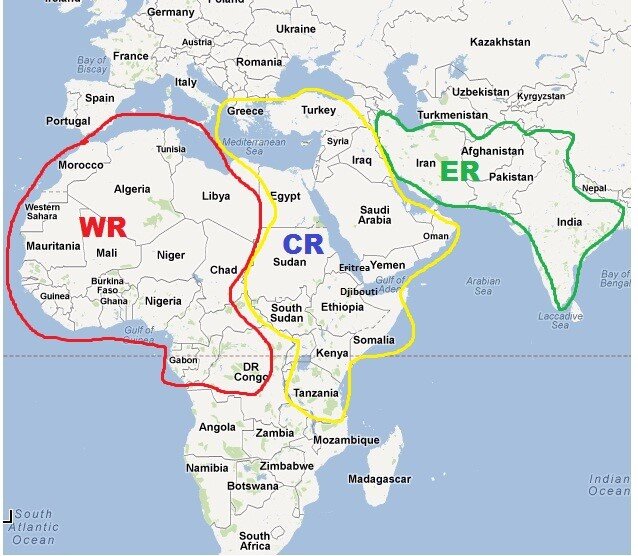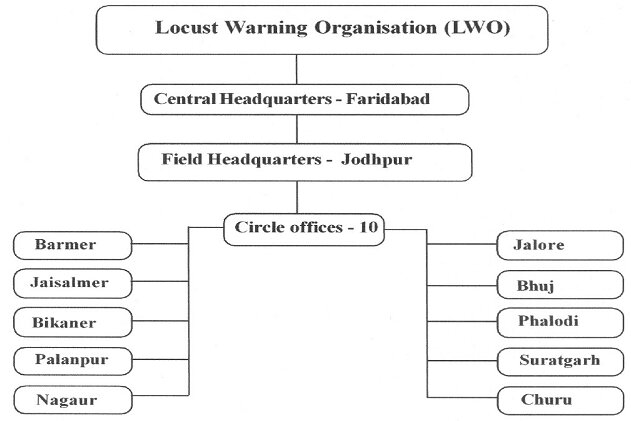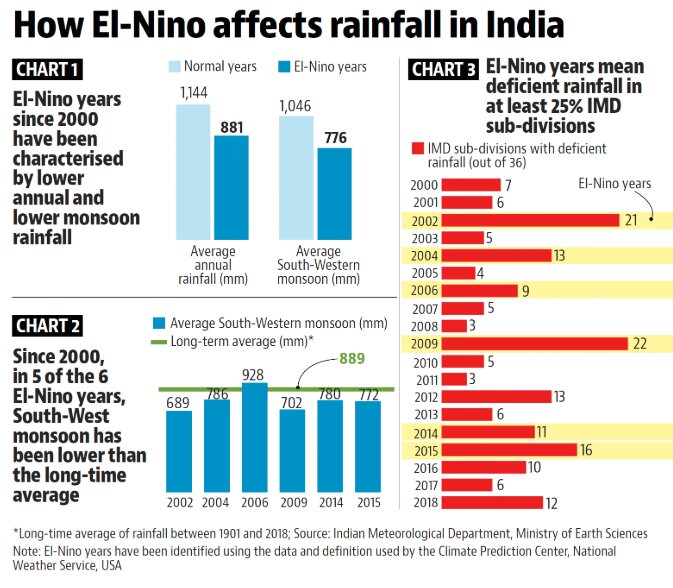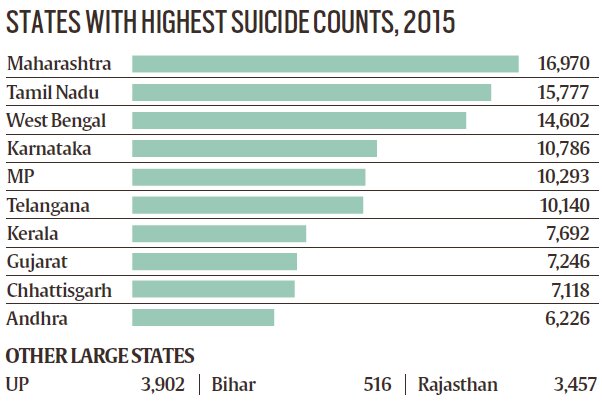Agriculture
Anti Locust Fight
The officials from India and Pakistan are closely working together to prevent the movement of locusts and save crops in bordering districts.
- Both the countries are also consistently sharing inputs, including satellite data, via Food and Agricultural Organization (FAO) to counter and restrict the movement of locusts.
Food and Agricultural Organization
- In 1945, Food and Agriculture Organization (FAO) was created In Quebec City, Canada, by the first session of the newly created United Nations.
- FAO is a specialized agency of the United Nations that leads international efforts to defeat hunger.
- FAO is also a source of knowledge and information, and helps developing countries in transition modernize and improve agriculture, forestry and fisheries practices, ensuring good nutrition and food security for all.
Locust
- A locust is a large, mainly tropical grasshopper with strong powers of flight. They differ from ordinary grasshoppers in their ability to change behaviour (gregarize) and form swarms that can migrate over large distances.
- Locusts are generally seen during the months of June and July as the insects are active from summer to the rainy season.
- Locusts have a high capacity to multiply, form groups, migrate over relatively large distances (they can fly up to 150 km per day) and, if good rains fall and ecological conditions become favourable, rapidly reproduce and increase some 20-fold in three months.
- Threat to Vegetation: Locust adults can eat their own weight every day, i.e. about two grams of fresh vegetation per day. A very small swarm eats as much in one day as about 35,000 people, posing a devastating threat to crops and food security.
- If infestations are not detected and controlled, devastating plagues can develop that often take several years and hundreds of millions of dollars to bring under control with severe consequences on food security and livelihoods.
- Locust Control measures include destroying egg masses laid by invading swarms, digging trenches to trap nymphs, using hopperdozers (wheeled screens that cause locusts to fall into troughs containing water and kerosene), using insecticidal baits, and applying insecticides to both swarms and breeding grounds from aircraft.
- FAO provides information on the general locust situation to the global community and gives timely warnings and forecasts to those countries in danger of invasion.
- The FAO raised alarm over the locust outbreak in northeast Africa and Saudi Arabia in February, 2019.
Locusts in India
- Four species viz. Desert locust (Schistocerca gregaria), Migratory locust (Locusta migratoria), Bombay Locust ( Nomadacris succincta) and Tree locust (Anacridium sp.) are found in India.
- The existing series of locust swarms that have entered India via Pakistan had originated in Iran. Movement of locusts is facilitated by summer dusty winds, which flow from the Arabian Sea, taking along these creatures from Sindh in Pakistan to western Rajasthan.
- These creatures have wreaked havoc in Pakistan but have not caused any damage on the Indian side.
- Locust Warning Organisation (LWO), Jodhpur is currently handling 13-16 swarms of locusts in Jaisalmer and Barmer districts of Rajasthan. It is currently using a pesticide 'malathion'.
- The last major locust outbreak that was reported in Rajasthan was in the year 1993.
Locust Warning Organization ( LWO)
- Locust Warning Organisation (LWO), Directorate of Plant Protection Quarantine and Storage, Ministry of Agriculture & Farmers Welfare, is responsible for monitoring, survey and control of Desert Locust in Scheduled Desert Areas mainly in the States of Rajasthan and Gujarat.
- Incursion of exotic locust swarms into India is prevented through organization of suitable control operation. LWO keeps itself abreast with the prevailing locust situation at National and International level through monthly Desert Locust Bulletins of FAO.
- Its objectives include:
- To monitor, forewarn and control locust in Scheduled Desert Area (SDA) being International obligation and commitment.
- To conduct research on locust and grasshoppers.
- Liaison and coordination with National and International Organizations.
- Human resource development through training and demonstration for staff of Locust Warning Organization (LWO), State officials, BSF personnel and Farmers.
- To maintain control potential to combat locust emergency by organizing locust control campaign.
Indian Economy
Heat Stress and Labour Productivity: ILO Report
The International Labour Organisation (ILO) in its report ‘Working on a Warmer Planet: The Impact of Heat Stress on Labour Productivity and Decent Work’ revealed that rising heat stress due to climate change could lead to the loss of 80 million jobs by 2030.
- The report makes its projections based on a global temperature rise of 1.5°Celsius by the end of the century.
Heat Stress
- It refers to heat in excess of what the body can tolerate without suffering physiological impairment.
- It generally occurs at temperatures above 35°C, in high humidity.
- Excess heat during work is an occupational health risk as it restricts workers
- Physical functions and capabilities,
- Work capacity and thus, productivity.
- Extreme heat can cause heat-related illnesses, such as heat stroke and exhaustion, increase mortality, and exacerbate existing health conditions.
- According to the World Health Organisation heat stress linked to climate change is likely to cause 38,000 extra deaths a year worldwide between 2030 and 2050.
Key Findings
- Economic Loss: 2% of total working hours worldwide is projected to be lost (costing the global economy $2.4 trillion) every year, either because it is too hot to work or because workers have to work at a slower pace.
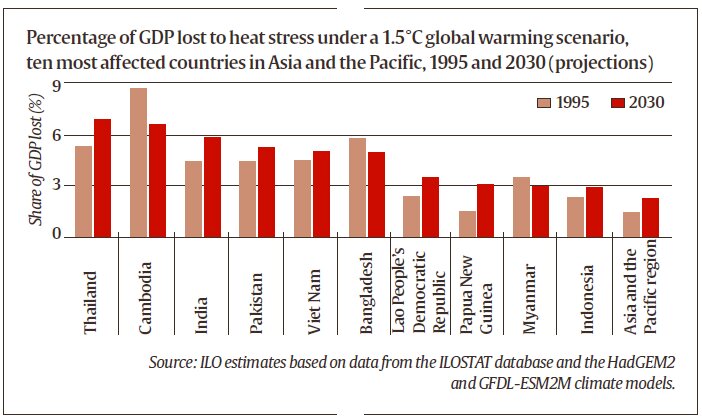
- Affected Sectors:
- Agricultural workers, especially women, who make up the bulk of the 940 million laborers in the sector will be most affected.
- Agricultural sector is projected to account for 60% of global working hours lost due to heat stress by the year 2030.
- Construction sector will also be severely impacted with an estimated 19% of global working hours lost by 2030.
- Other sectors like environmental goods and services, refuse collection, emergency, repair work, transport, tourism, sports and some form of industrial work will be worst affected by rising heat.
- Agricultural workers, especially women, who make up the bulk of the 940 million laborers in the sector will be most affected.
- Affected Regions:
- The regions losing the most working hours are expected to be southern Asia and western Africa, where approximately 5% of working hours are expected to be lost in 2030.
- According to ILO, India lost 4.3% of working hours in 1995 because of heat stress, and it is projected to lose 5.8% of its working hours in 2030, which corresponds to 34 million jobs.
- Most of the impact in India will be felt in the agricultural sector and more working hours are expected to be lost in the construction sector, where heat stress affects both male and female workers.
- Social Consequence:
- It could lead to more inequality between low and high income countries and worsening working conditions for the most vulnerable.
- Heat stress will affect millions of women who make up the majority of workers in subsistence agriculture, as well as men who dominate the construction industry.
- The social consequences of heat stress may include increasing migration, as workers leave rural areas to look for better prospects.
Way Forward
- Design, finance and implement national policies to address heat stress risks and protect workers.
- Adequate infrastructure and improved early warning systems for heat events, and improved implementation of international labour standards such as in the area of occupational safety and health to help design policies to tackle heat-related hazards.
- Employers and workers are best placed to assess risks and take appropriate action at the workplace so that workers can cope with high temperatures and continue to do their jobs.
- Employers can provide drinking water, and training on recognizing and managing heat stress.
- Social dialogue can play a crucial role in reaching consensus on indoor and outdoor working methods, adapting working hours, dress codes and equipment, use of new technologies, shade and rest breaks.
Agriculture
Credit Cards for Fishermen
Recently the Minister of State for Fisheries, Animal Husbandry and Dairying announced the extension of the facility of Kisan Credit Card (KCC) to fisheries and animal husbandry farmers to help them meet their working capital needs
- This will help fisheries and animal husbandry farmers to meet their short term credit requirements of rearing of animals, poultry birds, fish, shrimp, other aquatic organisms and capture of fish.
- Fish, Poultry & Dairy Farmers (individual & groups/partners/sharecroppers/tenant farmers), Self Help Groups, Joint Liability Groups and Woman group are eligible under extended KCC scheme.
- Under KCC facility, Interest subvention is available for animal husbandry and fisheries farmers @ 2% per annum at the time of disbursal of loan and additional interest subvention @ 3 % per annum in case of prompt repayment as Prompt Repayment Incentive (repayment of the loan within a period of one year from the date of advance).
Kisan Credit Card
- The Kisan Credit Card (KCC) scheme was introduced in 1998 for providing adequate and timely credit support from the banking system under a single window with flexible and simplified procedure to the farmers for their cultivation and other needs like purchase of agriculture inputs such as seeds, fertilizers, pesticides etc. and draw cash for their production needs.
- The scheme was further extended for the investment credit requirement of farmers viz. allied and non-farm activities in the year 2004.
- KCC covers Post-harvest expenses; Produce marketing loan; Consumption requirements of farmer household; Working capital for maintenance of farm assets and activities allied to agriculture; Investment credit requirement for agriculture and allied activities.
- The Kisan Credit Card Scheme is implemented by Commercial Banks, RRBs, Small Finance Banks and Cooperatives.
Interest Subvention Scheme
- The interest subvention scheme for farmers aims at providing short term credit to farmers at the subsidised interest rate.
- The policy came into force with effect from 2006-07
- The Interest Subvention Scheme is being implemented by NABARD and RBI.
- In case farmers do not repay the short term crop loan in time they would be eligible for interest subvention of 2% as against 5% available.
Science & Technology
Non-Communicable Diseases in India
- According to Indian Council of Medical Research (ICMR) report titled “India: Health of the Nation’s States”, contribution of Non-Communicable Diseases (NCDs) to total death in the Country was 61.8% in 2016, as compared to 37.9% in 1990.
- Some examples of common NCDs, i.e. diabetes, hypertension and cancers (Oral, Breast and Cervical cancer) are on the rise in India.
- Risk factors for NCDs inter alia include ageing, unhealthy diet, lack of physical activity, high blood pressure, high blood sugar, high cholesterol and overweight
- Also In the States of Kerala, Goa and Tamil Nadu, due to epidemiological transition, fewer deaths are recorded for communicable, maternal, neonatal and nutritional diseases, thereby raising the share of NCDs in total deaths
Epidemiologic Transition
- The epidemiologic transition is that process by which the pattern of mortality and disease is transformed from one of high mortality among infants and children to one of degenerative and man-made diseases (such as those attributed to smoking) affecting principally the elderly.
- Though public health is a State subject, Central Government supplements the efforts of the State Governments. For example:
- National Programme for Prevention and Control of Cancer, Diabetes, Cardiovascular Diseases and Stroke (NPCDCS) is being implemented under the National Health Mission (NHM).
- The objectives of the programme include health promotion activities and opportunistic screening for common Non-Communicable Diseases (NCDs) including cancer
- Key components of population-based screening include community-based risk assessment, screening, referral, and follow up of all individuals of 30 years and above for common NCDs
- The initiative will help in early diagnosis and will generate awareness on risk factors of NCDs.
- Citing growing occurrence of cancer in India, the Union government sought to enhance the facilities for tertiary care of cancer.
- The Central Government is implementing Strengthening of Tertiary Care Cancer facilities scheme to support setting up of State Cancer Institutes (SCI) and Tertiary Care Centres (TCCC) in different parts of the country.
- Oncology in its various aspects has a focus in case of new AIIMS and many upgraded institutions under Pradhan Mantri Swasthya Suraksha Yojana (PMSSY).
- Affordable Medicines and Reliable Implants for Treatment (AMRIT) Deendayal outlets have been opened at 159 Institutions/Hospitals with an objective to make available Cancer and Cardiovascular Diseases drugs and implants at discounted prices to the patients.
- Jan Aushadhi stores are set up by the Department of Pharmaceuticals to provide generic medicines at affordable prices.
- National Programme for Prevention and Control of Cancer, Diabetes, Cardiovascular Diseases and Stroke (NPCDCS) is being implemented under the National Health Mission (NHM).
International Relations
India Ratifies Convention to Prevent BEPS
Recently India has ratified the Multilateral Convention to Implement Tax Treaty Related Measures (MLI) to prevent Base Erosion and Profit Shifting (BEPS).
- The MLI is aimed to prevent firms from moving profit out of country.
- It ensures that profits are taxed where substantive economic activities generating the profits are carried out.
- Out of 93 tax treaties notified by India, 22 countries have already ratified the MLI so far and the Double Taxation Avoidance Agreement (DTAA) with these countries will be modified by MLI.
- For the remaining countries with tax treaties with India, the MLI will come into force when they ratify it.
- The MLI will come into force for India from October 1, 2019.
The Multilateral Convention to Implement Tax Treaty Related Measures (MLI)
- The multilateral convention is an outcome of the OECD/G20 project to tackle base erosion and profit shifting.
- This project was designed to work on anti-evasion measures that could curb tax planning strategies that exploit gaps and mismatches in tax rules to artificially shift profits to low or no-tax locations.
- Such geographies have little economic activity, resulting in little or no overall corporate tax being paid.
- The MLI will be applied alongside existing tax treaties, modifying their application in order to implement the BEPS measures.
- It will lead to amendments to double taxation avoidance agreements (DTAA) with the countries signatories to the convention to plug revenue leakages.
Governance
National Centre for Polar and Ocean Research (NCPOR)
The six himalayan glaciers, monitored by the National Centre for Polar and Ocean Research (NCPOR), have been retreating in the range of 13 to 33 millimetres per year.
- Six glaciers i.e. Sutri Dhaka, Batal, Bara Shigri, Samudra Tapu, Gepang Gath and Kunzum, are monitored for mass, energy and hydrological balance.
- Debris of thickness above two centimetres have reduced the melting rates up to 70 %, whereas the debris cover of below two centimetres thickness has accelerated melting up to 10 % of the total melting.
- The NCPOR has undertaken studies in the Western Himalaya in Chandra basin in Lahaul-Spiti (Himachal Pradesh) since 2013.
- The NCPOR has also established a high altitude research station named 'Himansh' in Himalaya at 4,000 metres altitude at Sutri Dhaka.
National Centre for Polar and Ocean Research (NCPOR)
- It was established as an autonomous Research and Development Institution of the Ministry of Earth Sciences on the 25th May 1998.
- Earlier known as National Centre for Antarctic and Ocean Research (NCAOR), NCPOR is India’s premier R&D institution responsible for the country’s research activities in the Polar and Southern Ocean realms.
- It is the nodal agency for planning, promotion, coordination and execution of the entire gamut of polar and southern ocean scientific research in the country as well as for the associated logistics activities.
- Its responsibilities include:
- Management and upkeep of the Indian Antarctic Research Bases “Maitri” and “Bharati”, and the Indian Arctic base “Himadri”.
- Management of the Ministry’s research vessel ORV Sagar Kanya as well as the other research vessels chartered by the Ministry.
- The Ocean Research Vehicle (ORV) Sagar Kanya is a versatile ocean observing platform equipped with technologically advanced scientific equipment and related facilities.
- Playing a facilitatory role in the scientific research activities being undertaken by several national institutions and organizations in Antarctica, the Arctic and in the Indian Ocean sector of the Southern Ocean.
- Playing a lead role in the geoscientific surveys of the country’s Exclusive Economic Zone (EEZ) and its extended continental shelf beyond 200m, deep-sea drilling in the Arabian Sea basin through the International Ocean Discovery Program (IODP), exploration for ocean non-living resources such as gas hydrates and multi-metal sulphides in mid-ocean ridges.
- It is located in the state of Goa.
International Ocean Discovery Program (IODP)
- It is an international marine research collaboration that explores Earth's history and dynamics using ocean-going research platforms to recover data recorded in seafloor sediments and rocks and to monitor subseafloor environments.
- It is in Phase II (tenured 2013-2023) of what was formerly known as the Integrated Ocean Drilling Program – Phase I.
- Phase I which was envisioned in the year 2003, ceased in October 2013, after which its 26 participating nations have continued collaboration through the International Ocean Discovery Program: Exploring the Earth under the sea. India joined the Phase I in the year 2009 as an Associate Member.
- India’s continued participation in Phase II as a member of the International Ocean Discovery Program is a result of an agreement signed in September 2014.
- NCPOR is the nodal agency for all the IODP related activities in India.
International Relations
National Defense Authorisation Act
The U.S. Senate has passed the National Defense Authorisation Act (NDAA) for the fiscal year 2020 that brings India at par with America’s NATO allies and countries like Israel and South Korea for increasing defence cooperation.
- The amendment provides for increased U.S.-India defence cooperation in the Indian Ocean in the areas of humanitarian assistance, counterterrorism, counter-piracy and maritime security.
- The bill would be signed into law after both the chambers of the U.S. Congress, i.e. the House of Representatives and the Senate passes it.
- The “upgrade” will also smoothen the passage of sales to India of high–end US military hardware to India.
- The US has already given India Strategic Trade Authorization-1(STA Tier-1) status, a move that facilitates the exchange of high technology and strengthens defence collaboration, and also designates India as a “Major Defence Partner”, in 2016.
- While the major non-Nato ally status or its equivalent, does not automatically enjoins a mutual defence pact with the United States (as it does with Nato allies), it still confers a variety of military and financial advantages that otherwise are not obtainable by non-NATO countries.
Geography
El-Nino Threatens Monsoon
According to the India Meteorological Department, the deficiency in rainfall in June was 33%.
- With the El-Nino phenomenon being observed since the beginning of 2019, there are fears that this might lead to a deficient monsoon.
- Deficient rainfall in June is devastating for farmers in large reaches of the country who have sown in expectation of rains.
- This shortfall is observed not only in aggregate but also across regions.
- Although a direct correlation between the two (rainfall deficiency & El-Nino) has not been established, rainfall data from 2000 onwards shows that monsoon rainfall is heavily impacted in the El-Nino years.
- In five of these six El-Nino years (2002,2004,2006,2009,2014,2015), the monsoon rainfall was lower than the long-term average by 12% to 23%.
Indian Society
Suicides in India
According to National Crime Records Bureau (NCRB)’s ‘Accidental Deaths and Suicides in India’ report for 2015, there were 1,336,623 suicides across the country that year.
- Among all states, Maharashtra (16,970) had the highest number of suicides in 2015.
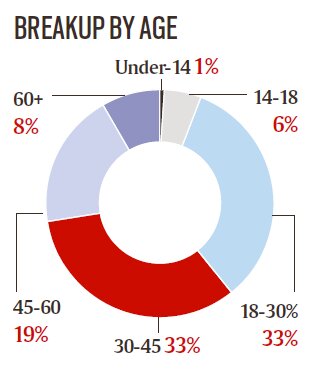
- It is followed by Tamil Nadu (15,777).
- In exception, Uttar Pradesh, the most populous state, had the 11th highest suicide count (3,902).
- Bihar, one of the country’s most populous states, was another exception, with its count of 516 suicides lower than that of many smaller states.
- As per report, one-third of the suicides in the country in 2015 were committed by young adults under age 30, and another one-third by people in the age group 30-45.
Important Facts For Prelims
Tamil Yeoman
Tamil Nadu has declared the Tamil Yeoman butterfly species (endemic to western ghats) as the state butterfly.
- Tamil Yeoman (Cirrochroa thais) is uniformly orange in colour with a dark brown outer ring.
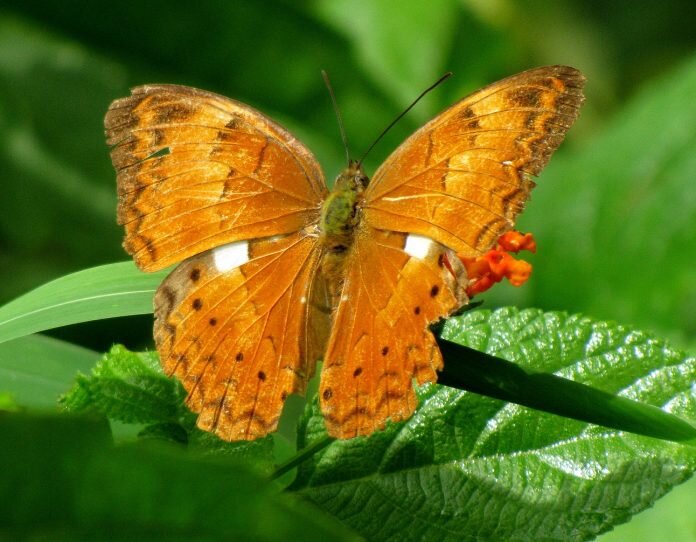
- Also known as tamil maravan which means warrior.
- Tamil Yeoman butterfly species moves in groups in large numbers, but at few places and are found mainly in hilly areas.
- Butterflies are significant for environment as they play the main role in pollination and food chain.
- For many other species like birds and reptiles, butterflies become a prey.
- Tamil Nadu is the fifth state in the country to announce its state butterfly and Maharashtra was the first in the country to announce its state butterfly (Blue Mormon) followed by Uttarakhand (Common Peacock), Karnataka (the Southern Birdwing) and Kerala (Malabar banded peacock or buddha butterfly).

